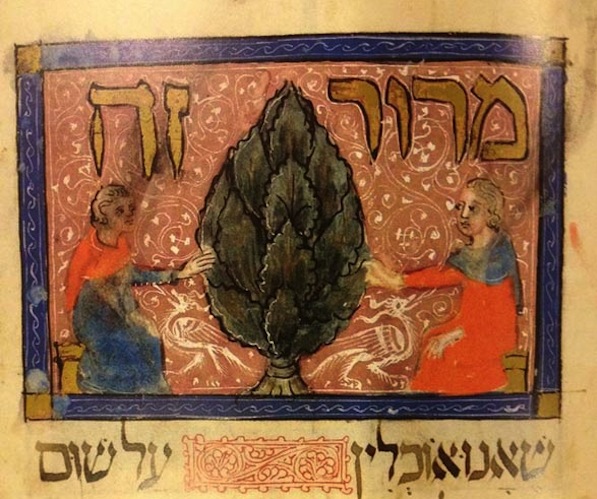Theater Preview: Rescuing — and Reimagining — the Sarajevo Haggadah
It was not the first time the Sarajevo Haggadah had benefited from Muslim protection: during the Nazi occupation, another librarian had spirited the Hebrew manuscript out of danger and hidden it in a local mosque.
By Debra Cash
The Sarajevo Haggadah: Music of the Book. A world premiere production at Yellow Barn, Putney, Vermont, on March 20 and 22, and on March 26 at the Arsenal Center for the Arts, Watertown, MA.
At the start of the Bosnian war in 1992, musician Merima Kljuco was 18 years old. As a child, she had fallen in love with the sound of the accordion and Balkan music’s culturally mixed repertoire. But the former Yugoslavia was splintering into ethnic factions. After two years under fire, she fled to the Netherlands and later settled in Los Angeles where she became a noted recitalist specializing in both folk and contemporary music.
Four years ago she heard a story that inspired an ambitious multimedia project that has its world premiere in Putney Vermont this week, quickly followed by a sold-out performance in Boston’s Jewish Music Festival.
A friend gave her a copy of Geraldine Brooks’ People of the Book, a novel that imagines the journey and rescue of the Sarajevo Haggadah, a rare Spanish medieval codex that chronicles the Biblical story of the Jewish liberation from slavery. (Haggadahs are used in the home-based ceremony of the Passover seder.) Brooks had learned of the haggadah, one of the earliest Jewish volumes ever to be illuminated with figurative paintings, while working as a Wall Street Journal correspondent in Bosnia. It was missing from the state museum, rumors went; perhaps it had been stolen and sold for weaponry or smuggled out of the country for safekeeping.
The truth, it turned out, was unexpected. A Muslim librarian had dodged Serbian shells to retrieve the manuscript and had stashed it in a bank vault. It was not the first time the Hebrew manuscript had benefited from Muslim protection: during the Nazi occupation, another librarian had spirited the manuscript out of danger and hidden it in a local mosque.
Kljuco, who most recently performed Jewish klezmer music from Eastern Europe here in Boston on a program with Theodore Bikel, first fell in love with Jewish music as a teenager. As she tells the story, “I was walking through the streets when, passing by the music shop, I heard a beautiful melody. The sound was somehow very familiar to me, but still different from anything I had heard before. I couldn’t resist going into the shop to ask what it was.” They told me it was “Sephardic music”:
I was, and still am, mesmerized by this music, the music of Sephardic Jews. It has its roots in the musical tradition of the Jewish communities in medieval Spain and was brought to the Balkans, among other places, after the expulsion of the Jews from Spain in 1492.
Sephardic Jews observed the traditions of their home countries, and infused Jewish culture into the music of their adopted lands. This resulted in musical similarities. For example, Bosnians and Sephardic Jews use the same scales and rhythms. They share the same emotion in their songs, the same pleasures, and the same pain. In the end they share the same country, the same customs, and the same food. They learn from each other. And an interesting note: many Sephardic songs from Bosnia are about celebrating Passover.
I have learned most of Sephardic songs from my dear friend Flory Jagoda, a Bosnian expert in the field of Sephardic music. Flory is a Sephardic Jew who left Bosnia during the Second World War and is now living in Washington D.C. We understand each other on many levels as we share a very similar destiny, with a difference of just a few decades.
Originally conceived as a composition for solo accordion, the music for the Sarajevo Haggadah grew to a multimedia project during a chamber music residency at Yellow Barn in Putney, Vermont. Support came from a commission by the Foundation for Jewish Culture’s New Jewish Culture Network, a cohort of performing arts presenters committed to the creation and touring of innovative projects. (While the Foundation itself has disbanded, the network will continue to fund artists across genres.)
Developed for the most part over Skype and file sharing, the music for The Sarajevo Haggadah: Music of the Book combines Kljuco’s work with piano played by the Yellow Barn’s director, Seth Knopp, and “digital illuminations” by video artist Bart Woodstrup. The composition’s twelve movements trace the Haggadah’s journey and brings together, Kljuco says, the musical tradition of Sephardic Jews, Spain, Italy, Austria, Bosnia, and Herzegovina. (The Boston performances are followed by a discussion with Merima and Geraldine Brooks.)
The journey of the Sarajevo Haggadah — and the symbolism of its cross-cultural protection — has become a metaphor for Merima Kljuco’s own journey.
“The Sarajevo Haggadah is a story of a survivor, and is also a metaphor for my personal story,” she says. “The Haggadah in its journey suffered transformations, which make it even more special by giving it a richer history that reflects its passage through different cultures. I also travel around the world and with every journey I get a new “scar,” positive or negative, but I keep my dignity and get richer by traveling through different circumstances, and sharing culture with others through my music.”
Debra Cash has reported, taught and lectured on dance, performing arts, design and cultural policy for print, broadcast and internet media. She regularly presents pre-concert talks, writes program notes and moderates events sponsored by World Music/CRASHarts and cultural venues throughout New England. A former Boston Globe and WBUR dance critic, she is a two-time winner of the Creative Arts Award for poetry from the Hadassah-Brandeis Institute and will return to the 2014 Bates Dance Festival as Scholar in Residence.
c 2014 Debra Cash
Tagged: Balkan, Jewish music, Merima Kljuco, musical, Sephardic Music

